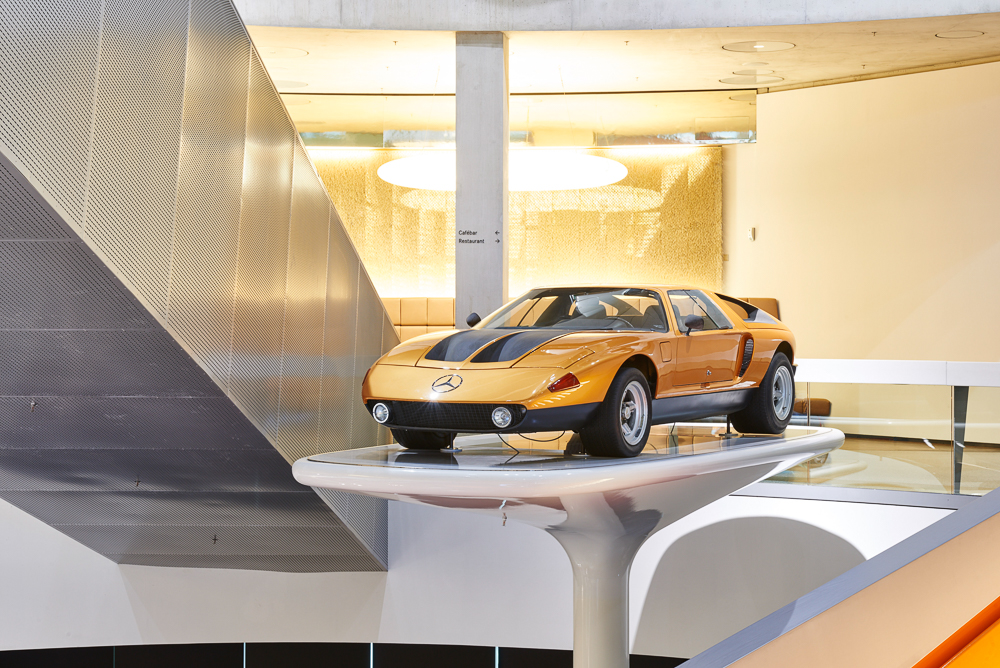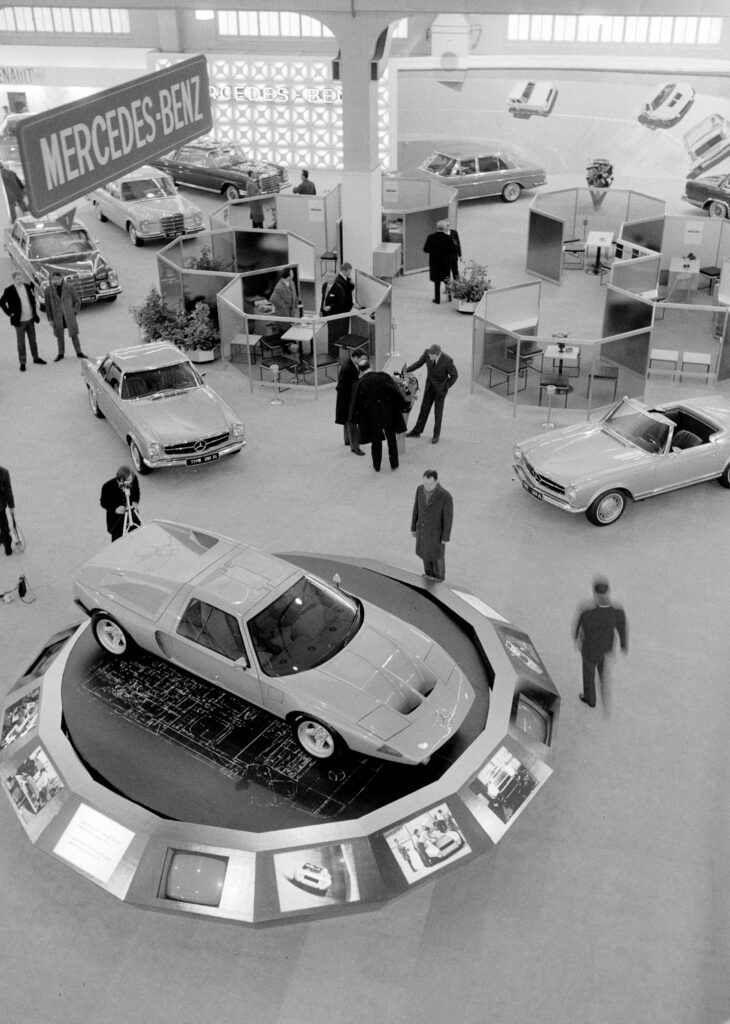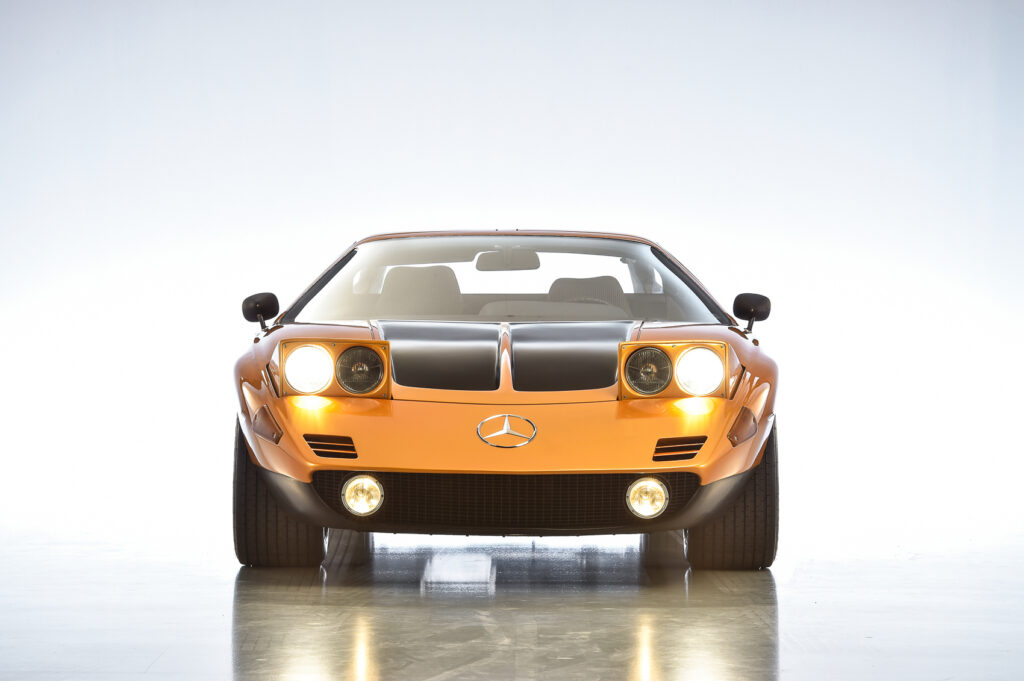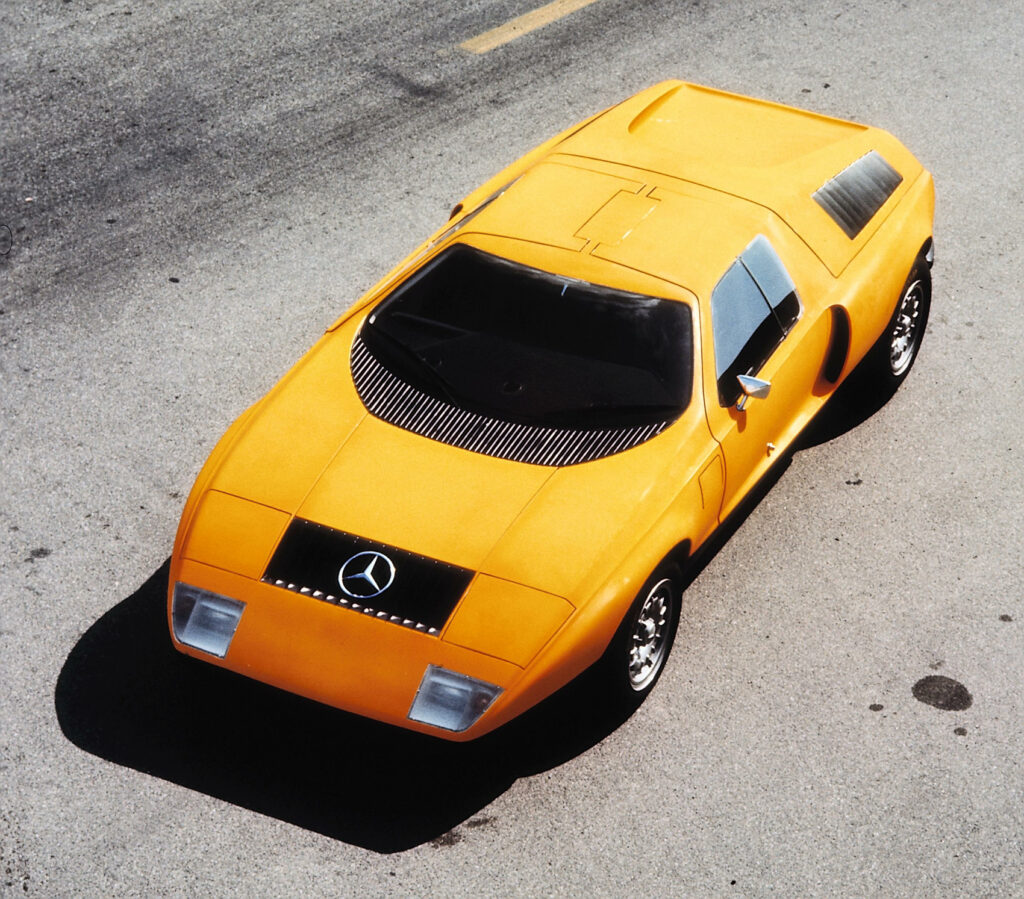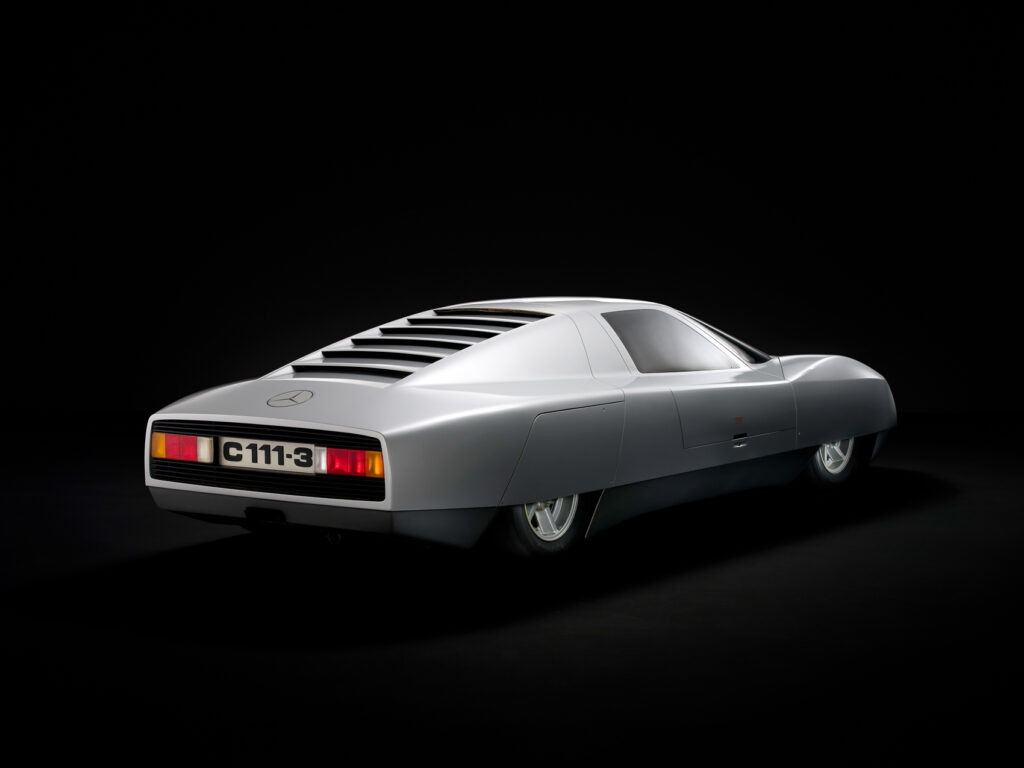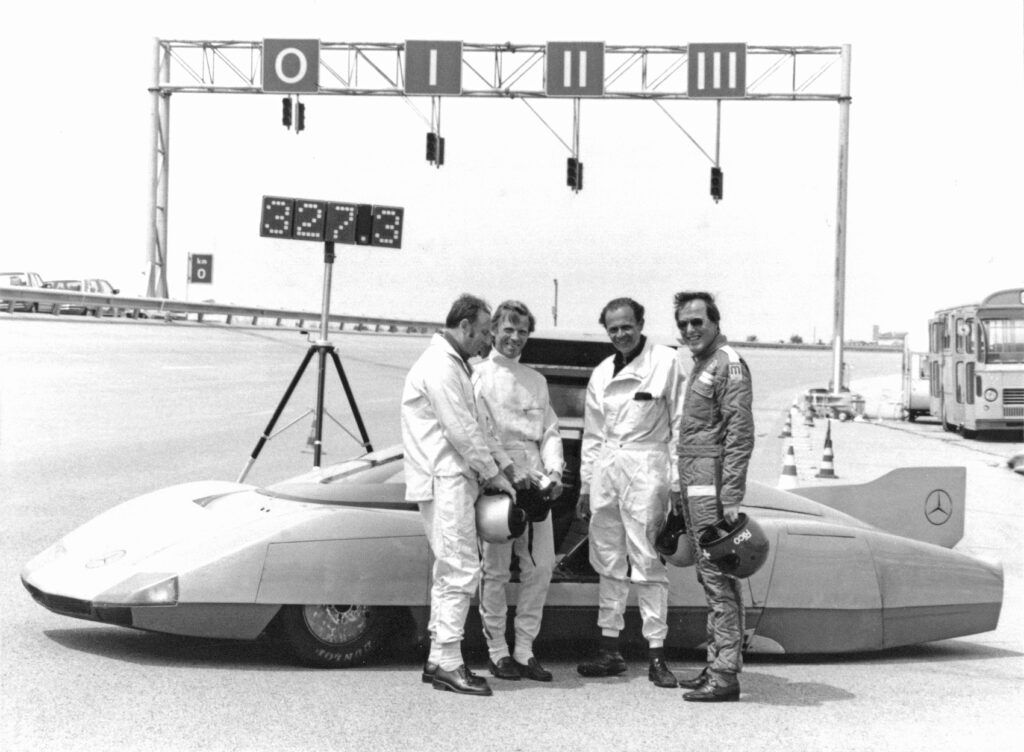The day Mercedes unveiled the C 111-II concept at Geneva
Features | PetroliciousCo
Is this the most significant Mercedes ‘concept’ in history?
Originally posted – 23 March, 2020 | PetroliciousCo
Half a century ago, on 22 March 1970, the Mercedes C 111-II was unveiled to the motoring world at the 40th Geneva Motor Show. But while many – read hundreds – of concepts have fallen by the wayside after their time under the Geneva Motor Show spotlights, the Mercedes C 111 has somehow withstood the test of time, even 50 years on from its event debut.
That the C 111 wasn’t a conventional Mercedes was certainly a good start. The designers, under the direction of Bruno Sacco before he moved on to the ‘W126’ gen S-Class, opted to forego Merc’s customary curves and fender-mounted headlamps in favour of a lower and considerably sleeker approach, one more akin to the wedged-shaped Alfa Romeo Carabo and Holden Hurricane, and later typified by the likes of the Stratos Zero, Ferrari Modulo and DeLorean’s DMC-12.
But there was more to the C 111 than just heartstring-strumming bodywork. The “test lab on wheels” – so, not a ‘concept’ in the traditional sense – was designed specifically as an experimental model, one with which Mercedes would showcase a bodyshell made from glass-fibre-reinforced plastic, revised suspension components for use with wider tyres, and, foremost on Mercedes’ checklist, the efficiency of Wankel engines. Ironically the latter would be abandoned altogether after only a few years, and following a near six-year hiatus, the C 111, now powered by and promoting Mercedes’ diesel engine, was reinvented as a ‘proper’ speed record aspirant.
50 years on from its Geneva debut, it’s quite a story.
As early as 1963, talk at Mercedes had turned to the feasibility of Wankel engines, given the simplicity of the unit compared with the traditional reciprocating piston, its compact size, smoother running, and, in theory at least, a higher power-to-weight ratio. Sound reasoning. Mazda, after all, debuted the world’s first mass production car powered by a two-rotor rotary engine, the Cosmo Sport, in May 1967, and was still promoting Felix Wankel’s innovative design when the RX-8 arrived more than three decades later. By then of course, development work had also begun on, what Mercedes internally called, its ‘C 101’ experimental vehicle.
Designed specifically with a futuristic shape, the C 111 was always going to cause a stir. The prototype stood barely 1,120mm tall (less than 3.5ft) and was built atop a wheelbase just over eight feet long (2,620mm). It was also, as Mercedes claims, the world’s first vehicle to be completely designed on a computer, an inventive technique that allowed the brand’s engineers to calculate dynamic loads and cut the development period by a hefty four months. The ESEM-designed GFRP body was then screwed directly to the sheet steel underbody frame for added stability.
The famous ‘Weissherbst’ metallic orange paintwork? Try to control yourself, but that also only made its debut at Geneva in 1970, the C 111 prototype before that having donned a plainer, pearlescent white with orange accents. Very Porsche 917!
Initial tests of the C 111 spoke volumes of the rotary engine too. At an extended text program across April and May in 1969, and incorporating Untertürkheim, the Hockenheimring and (naturally) the Nürburgring, the three-rotor Wankel produced a stellar 280hp and proved capable of up to 260kph. Also being tested was new anti-squat and anti-dive controls in the suspension as well as a brand new front axle, each of which would later be incorporated into Mercedes’ production range. With a successful test program complete, the uber sleek C 111’s global debut finally came at the 1969 Frankfurt Motor Show that September, gullwing doors proving the icing atop the kuchen. Autocar magazine at the time even referred to the C 111 as “the unrivalled dream car of an entire generation.” Praise from Caesar indeed.
Not long after, the prototype C 111 was touring motor shows in Paris and London (October 1969), Turin (October/November), Vienna (November), Essen (December), Brussels (January 1970) and Chicago (February), interest in Mercedes’ apparent ‘spiritual successor to the 300 SL’ understandably through the roof. However, though buoyed by interest both from the public and the media – one German entrepreneur is rumoured to have offered half a million Deutschmarks for the model on display in London – Mercedes was adamant that no customer models would be sold. After, the company had only scratched the surface of the C 111’s potential.
Enter the C 111, version 2.0, which debuted this week 50 years ago at the 40th Geneva Motor Show in March 1970. Complete with Weissherbst metallic orange paint.
Though aesthetically similar, the newly updated and renamed ‘C 111-II’ was a far cry from its conceptual predecessor, featuring as it did a modified bootlid and roof to improve the driver’s field of vision. Further optimised aerodynamics – even the mudguards received a tweak – meant version 2.0 now produced eight per cent less drag than the original ’69 prototype, and inside, there was now a simplified dashboard and contoured fabric seats. At the specific behest of Rudolf Uhlenhaut, head of Mercedes-Benz Passenger Vehicle Development, there was now room for two items of luggage on the boot lid as well. There was even room for a pair of skis, should non-customers suddenly find themselves in the middle of a Bond film.
Gone also was the three-rotor Wankel in favour of a gutsier quadruple-rotor example, one that chucking out a more robust 350hp and thus making the more refined “test lab on wheels” capable, reportedly, of 300kph and 0-100kph in just 4.8 seconds. No mean feat, given that it took a Mk.III Ford GT40 just three-tenths more to cover the same distance.
Performance was not enough to save the Wankel engine in Mercedes’ war room, however. Ever-heightening emissions legislation in the United States and questionable durability meant that by December 1970, the gas-guzzling Wankel had already been replaced with a production-ready 3.5-litre V8, Mercedes’ development kitty now earmarked elsewhere.
Even a diesel V8 was not enough to save the C 111-II from the chopping block though, heavy pressure on manufacturers to increase passive safety in all of their vehicles effectively drawing a line through the car’s glass-fibre-reinforced plastic bodywork too. Having steamed out of the blocks at Frankfurt in 1969, and drawn yet more headlines at Geneva in 1970, the C 111-II looked set to be ‘just another’ Geneva concept after all.
In the fallout of the 1973 Oil Crisis, during which the price of oil rose by up to 400 per cent per barrel, economical diesel engines were now at the forefront of the automotive industry. This, despite the engine’s not unreasonable reputation as a loud, lame duck when it came to performance. Mercedes, already developing and promoting its fleet of diesel engines, looked to change that, and what better way than with an aerodynamically proficient test lab the company could easily pull out of storage?
And so, on 12 June 1976, the C 111-II turned its first wheel in anger in close to six years at the newly built, high speed Nardò Ring in Italy, making history in the process.
Largely unchanged since its last public appearance – even the Weissherbst paint had survived – the most significant change lay beneath the surface. Gone was the V8, replaced by an ‘OM617 LA’ series, 3-litre five-cylinder diesel engine plucked from Mercedes’ production 300D saloon, complete with Garret turbocharger and intercooler. Granted, the comparatively low 190hp was a significant drop from its heading 350hp, though this still marked a considerable leap over the engine’s production-ready 80hp. Not that it mattered. Over the course of 60 hours, with four test drivers working in 2.5-hour shifts, the newly renamed ‘C 111-IID’ – as in ‘diesel’ – blitzed the 12.5km Nardò Ring at an average speed of 252kph, breaking 13 world records in the process for diesel cars and a further three outright. Mercedes management was overjoyed. Mercedes’ marketing team could scarcely contain itself.
Merc’s technicians though, as in 1969, were still dissatisfied. They were convinced, given the proper ‘race car’ treatment, that the C 111 could indeed break the hallowed 300kph barrier with a diesel engine. With yet more marketing promotion being dangled before its eyes, management agreed, and by mid-1977, development had begun on the most radical overhaul the C 111 would ever receive.
Cue the C 111-III, a thoroughbred racing car with all the aerodynamic accoutrement to match. Indeed, nomenclature aside, there was little similarity between version 3.0 and its conceptual forebear.
Underneath, the already sizable wheelbase was made even longer, the track narrowed, and the very low front end darted into the asphalt before it. The slick bodywork remained, including the gullwing doors, albeit now covering the aluminium wheels and with a tapered rear end away at the rear. The once pop-up headlights were now recessed, and over the rear axle, an enormous central fin was mounted to provide straight-line stability under side wind conditions. In true silver arrows tradition, the metallic orange paintwork was also gone.
The turbocharged five-cylinder remained intact, though tweaks meant the diesel unit now pushed 230hp. Inside, the “contemporary aesthetics” were already a forgotten memory, the cabin now boasting only a single-seat as the passenger space and wheel well was consumed by telemetry, radio equipment, and a chuffing great pipe sending air to the intercooler. Luggage space? Don’t be silly.
Much as its predecessor had done, on 30 April 1978, again at Nardò and eight years and just over a month after the production-esque C 111-II’s debut at Geneva, the thoroughbred C 111-III ran at high speed for close to 12 hours, a program interrupted only by an unsighted hedgehog that, regrettably, chose a poor time to inspect the oval track, demolishing the car’s front spoiler in the process.
Despite the delay (ironically the team’s spare car managed to run five laps longer between refuelling), Mercedes’ test lab wrote itself into the record books once again, setting an incredible NINE absolute world records in the process, including a 314.463kph average speed across 12 hours. All with a near-production three-cylinder diesel engine, and with a car that, close to nine years earlier, had debuted in Frankfurt promoting GFRP bodywork and rotary engines. And, incredibly, without a single production version being sold in the interim. It’s a legacy, more than 50 years on, truly deserving of celebration.
That would be as good a place as any to end this story, but the C 111 had one last trick up its plastic sleeves.
On 9 August 1975, former Can-Am champion Mark Donohue had taken his 1,000hp-plus Porsche 917-30 up to a spine-snapping 355.854kph at the Talladega Superspeedway in Alabama. With its race-spec C 111 now capable of over 300kph, the record, despite not being officially recognise by the FIA, was now a target in the silver arrows’ crosshairs.
Just another 100hp would do it, but with the diesel five-cylinder already bursting at its seams, Mercedes instead opted to use a production, petrol-driven (yikes!) 4.5-litre V8 plucked directly from its production line, one boosted to 4.8-litres then mated with twin turbochargers from Kuhle, Kopp & Kausch. The result was a screaming 500hp and torque rocketing past 600Nm (443lb ft).
After some more aerodynamic fettling, including a heavier duty front splitter, additional rear spoilers, two rather than one central fins at the back, and removable of the headlights altogether, the newly updated C 111-IV glided to a new, and official, 403.978kph world circuit record on 5 May 1979. A run that bested Donohue’s best by 48.124kph.
A test lab. A design icon. A rotary-powered experiment. A diesel champion. A destroyer of world records. 50 years after its Geneva Motor Show debut, you certainly couldn’t call the Mercedes C 111 ‘just’ another concept.
Images | Daimler Media
Features | PetroliciousCo | James Gent

